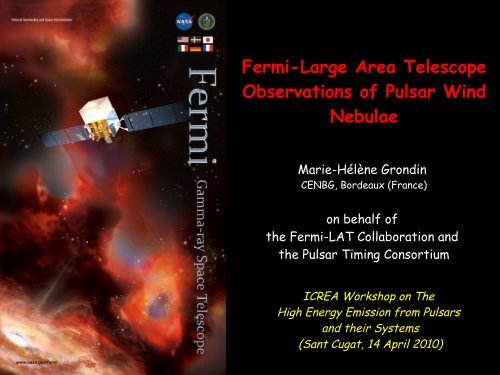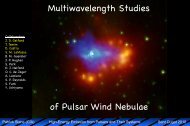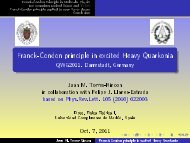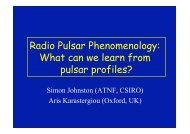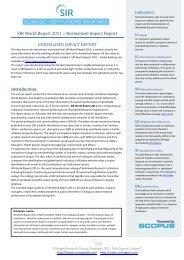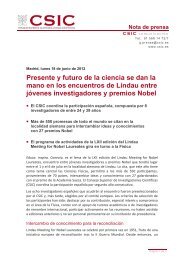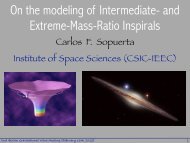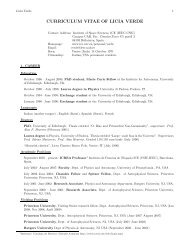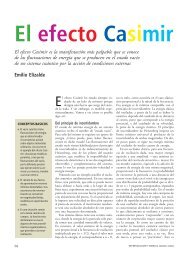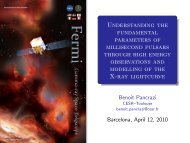Fermi Large Area Telescope Observations of Pulsar Wind Nebulae
Fermi Large Area Telescope Observations of Pulsar Wind Nebulae
Fermi Large Area Telescope Observations of Pulsar Wind Nebulae
- No tags were found...
You also want an ePaper? Increase the reach of your titles
YUMPU automatically turns print PDFs into web optimized ePapers that Google loves.
<strong>Fermi</strong>-<strong>Large</strong> <strong>Area</strong> <strong>Telescope</strong><strong>Observations</strong> <strong>of</strong> <strong>Pulsar</strong> <strong>Wind</strong><strong>Nebulae</strong>Marie-Hélène GrondinCENBG, Bordeaux (France)on behalf <strong>of</strong>the <strong>Fermi</strong>-LAT Collaboration andthe <strong>Pulsar</strong> Timing ConsortiumICREA Workshop on TheHigh Energy Emission from <strong>Pulsar</strong>sand their Systems(Sant Cugat, 14 April 2010)M.-H. Grondin, High-Energy Emission from <strong>Pulsar</strong>s and their Systems, April 2010
<strong>Pulsar</strong> <strong>Wind</strong> <strong>Nebulae</strong> (PWNe)•<strong>Pulsar</strong> <strong>Wind</strong> <strong>Nebulae</strong> :–Relativistic particles (e ± ) injected bythe central pulsar–Ejecta <strong>of</strong> the supernova sweeps up–Flow decelerated at the shock–Particles accelerated at the shock(Diffusive Shock Acceleration)–Non-thermal photons emitted by : Synchrotron Bremsstrahlung Inverse Comptonscattering (leptonicscenario) Pion decay (hadronicscenario)•High energy observations can help constraining the properties <strong>of</strong> thePWN (age, injection spectrum, maximum particle energy and breaks,nebular magnetic field, ambient photon field, etc.)(Gaensler & Slane, 2006, ARA&A, 44, 17)M.-H. Grondin, High-Energy Emission from <strong>Pulsar</strong>s and their Systems, April 2010 2
CGRO-EGRET (1991-2000)Compton Gamma-Ray Observatory(CGRO)(Credit: NASA)Energetic Gamma-RayExperiment <strong>Telescope</strong>(CGRO-EGRET)20 MeV-30 GeV(Credit : NASA)M.-H. Grondin, High-Energy Emission from <strong>Pulsar</strong>s and their Systems, April 2010 3
The γ-ray sky before <strong>Fermi</strong>CrabAGN - blazarsNon id.pulsarsLMCEGRET All-sky Gamma-Ray Survey above 100 MeV(de Jager et al, 1996, ApJ, 457, 253)M.-H. Grondin, High-Energy Emission from <strong>Pulsar</strong>s and their Systems, April 2010 4
<strong>Fermi</strong>-LAT 1-year catalog(Abdo et al, 2010, ApJS, submitted, arXiv:1002.280)MSH 15-52Vela-XCrab1451 sources detected between 100 MeV and 100 GeV with TS > 25( http://fermi.gsfc.nasa.gov/ssc/data/access/lat/1yr_catalog/ )M.-H. Grondin, High-Energy Emission from <strong>Pulsar</strong>s and their Systems, April 2010 5
The Crab Nebula• <strong>Pulsar</strong> <strong>Wind</strong> Nebula G184.6-5.8 akaCrab Nebula, powered by the Crab<strong>Pulsar</strong> (B0531+21, dE/dt = 4.6x10 38erg/s)• No SNR shell detected• Distance = (2.0 ± 0.2) kpc,characteristic pulsar age = 1240 yr• Spectrum <strong>of</strong> the nebula spanning 21decades in frequency, from radio to~80 TeV, emission predominantly bynon-thermal processesM.-H. Grondin, High-Energy Emission from <strong>Pulsar</strong>s and their Systems, April 2010 6
Earlier γ-ray observations <strong>of</strong> the Crab Nebula•EGRET observations <strong>of</strong> the synchrotron/Inverse Compton spectrumin the 70 MeV – 30 GeV energy band (De Jager et al., 1996, ApJ, 457,253):–<strong>Large</strong> uncertainties on the spectrum shapes for both components–Variability observed at 3.1σ level below 150 MeV–no cut-<strong>of</strong>f detected for the inverse Compton component<strong>Fermi</strong>•MAGIC observations above 60 GeV(Albert et al, ApJ, 674, 1037, 2008):Inverse Compton peak energyestimated at (77 ± 35) GeVSpectral energy distribution <strong>of</strong> the CrabNebula (Horns & Aharonian, ESAPS552:439, 2004)M.-H. Grondin, High-Energy Emission from <strong>Pulsar</strong>s and their Systems, April 2010 7
LAT <strong>Observations</strong> <strong>of</strong> the Crab <strong>Pulsar</strong> and Nebula(Abdo et al., 2010, ApJ, 708, 1254)The following studieswere performed with8 months <strong>of</strong> data insurvey modeLight curve <strong>of</strong> the Crab <strong>Pulsar</strong>.Two cycle are shown.LATpr<strong>of</strong>ileabove 100MeVOff-pulse1.4 GHzradiopr<strong>of</strong>ileM.-H. Grondin, High-Energy Emission from <strong>Pulsar</strong>s and their Systems, April 2010 8
LAT <strong>Observations</strong> <strong>of</strong> the Crab <strong>Pulsar</strong> and Nebula(Abdo et al., 2010, ApJ, 708, 1254)Spectral analysis <strong>of</strong> the nebula :– Performed in the <strong>of</strong>f-pulse window– Synchrotron and inverse Compton (IC) components are resolved :Spectral index (sync) = (3.99 ± 0.12 ± 0.08)Spectral index (IC) = (1.64 ± 0.05 ± 0.07)Flux above 100 MeV = (9.8 ± 0.7 ± 1.0)x10 -7 cm -2 s -1– No significant cut-<strong>of</strong>f and variability can be observed, neither for thesynchrotron nor for the IC component with 8 month <strong>of</strong> data in surveymodeSpectral energy distribution<strong>of</strong> the Crab NebulaM.-H. Grondin, High-Energy Emission from <strong>Pulsar</strong>s and their Systems, April 2010 9
LAT <strong>Observations</strong> <strong>of</strong> the Crab <strong>Pulsar</strong> and Nebula(Abdo et al., 2010, ApJ, 708, 1254)Synchrotron component fit with COMPTEL + LAT => cut-<strong>of</strong>f at ~100 MeVNo cut-<strong>of</strong>f seen with LAT data only for the IC componentLAT high energy and Cherenkov spectra link up naturallyOverlaying predictions <strong>of</strong> Atoyan & Aharonian (1996, MNRAS, 278, 525) fordifferent mean magnetic fields, the results obtained by the LAT and groundbased telescopes are consistent with 100 µG < B < 200 µG, indicating amagnetic field well beyond the equipartition field in the Crab nebula (300 µG)Spectral enery distribution<strong>of</strong> the Crab Nebula.100 µG200 µG300 µGM.-H. Grondin, High-Energy Emission from <strong>Pulsar</strong>s and their Systems, April 2010 10
LAT <strong>Observations</strong> <strong>of</strong> the Crab <strong>Pulsar</strong> and Nebula(Abdo et al., 2010, ApJ, 708, 1254)• Spectral analysis <strong>of</strong> the pulsar :• Performed on the whole pulse phase interval• Best fit above 100 MeV obtained with a power-law with an exponentialcut-<strong>of</strong>f :• Spectral Index = (1.97 ± 0.02 ± 0.06)• Cut-<strong>of</strong>f energy = (5.8 ± 0.5 ± 1.2) GeV• Flux above 100 MeV = (2.09 ± 0.03 ± 0.18)x10 -6 cm -2 s -1• Pulsed photons observed up to ~20 GeV : consistent with an emittingregion well above the NS surfaceSpectral energy distribution<strong>of</strong> the Crab <strong>Pulsar</strong>See also R. Shannon and V.Kondratiev's talk on tuesdayM.-H. Grondin, High-Energy Emission from <strong>Pulsar</strong>s and their Systems, April 2010 11
Multi-wavelength observations <strong>of</strong> Vela X• Elongated cocoon-like hard X-ray structure extends southward <strong>of</strong> pulsar:– clearly identified by HESS as an extended VHE structure– this is not the pulsar jet (which is known to be directed to NW); presumablythe result <strong>of</strong> reverse shock interaction• Extended area (halo) <strong>of</strong> size 2°x3° (including the cocoon area) seen in radio• An upper limit, assuming a point source at the position <strong>of</strong> Vela PSR, wasreported using the first 75 days <strong>of</strong> <strong>Fermi</strong> data: F(>100 MeV) < 4.5x10 -7 cm - 2 s-1(Abdo et al., 2009, ApJ, 696, 1084)ChandraHESSComposite ROSAT-RASS image <strong>of</strong>Vela SNRwith 8.4 GHz Parkesradio contours overlaid(LaMassa et al, 2008,ApJ, 689, L121)M.-H. Grondin, High-Energy Emission from <strong>Pulsar</strong>s and their Systems, April 2010 12
The Vela <strong>Pulsar</strong>: Results from the First Year <strong>of</strong><strong>Fermi</strong> LAT <strong>Observations</strong>(Abdo et al., 2010, ApJ, 713, 154)Off-pulse<strong>Fermi</strong> LAT light curve <strong>of</strong> Vela above 20 MeV. Two cycles are shown.M.-H. Grondin, High-Energy Emission from <strong>Pulsar</strong>s and their Systems, April 2010 13
LAT <strong>Observations</strong> <strong>of</strong> Vela X (morphology)(Abdo et al., 2010, ApJ, 713, 146)• Study performed with 11 months <strong>of</strong> data in survey mode• Bright emission South <strong>of</strong> the Vela pulsar + fainter emission to the East• Gamma-ray complex lies within Vela-X (as seen in radio)• Significantly extended : best fit above 800 MeV obtained with a uniformdisk <strong>of</strong> radius 0.88°± 0.12°• Additional source coincident with the SNR Puppis AVela <strong>Pulsar</strong>TS map <strong>of</strong> the <strong>of</strong>f-pulse windowabove 800 MeV.61 GHz radiocontours (WMAP)Puppis AM.-H. Grondin, High-Energy Emission from <strong>Pulsar</strong>s and their Systems, April 2010 14
LAT <strong>Observations</strong> <strong>of</strong> Vela X (spectrum)(Abdo et al., 2010, ApJ, 713, 146)Analysis in the <strong>of</strong>f-pulse window, performed for 200 MeV < E < 20 GeVSpatial template used: uniform diskVela-X spectral parameters (renormalized to the total phase):– Spectral index = 2.41 ± 0.09 stat± 0.15 syst(s<strong>of</strong>t spectrum)– Flux above 100 MeV = (4.73 ± 0.63 stat± 1.32 syst)x10 -7 cm -2 s -1No indication <strong>of</strong> a spectral cut-<strong>of</strong>f at high energySpectral energy distribution <strong>of</strong> Vela XM.-H. Grondin, High-Energy Emission from <strong>Pulsar</strong>s and their Systems, April 2010 15
LAT <strong>Observations</strong> <strong>of</strong> Vela X (spectrum)• As noted by de Jager et al. (2008, ApJ, 689, L125), the SED strongly favors a twocomponentleptonic model• Hadronic model is disfavoured• SEDs were computed from evolving power-law electron populations, one eachfor the X-ray/VHE-peak cocoon and radio/MeV-peak halo:– Halo : This region requires a 130 GeV exponential cut-<strong>of</strong>f controlledby the cut-<strong>of</strong>f <strong>of</strong> the injected spectrum– Cocoon :• Synchrotron/Comptonpeak ratio <strong>of</strong> the cocoonimplies a B=4µG with smalluncertainty• This region requires a 600TeV exponential cut-<strong>of</strong>fcontrolled by the coolingbreakMultiwavelength spectrum <strong>of</strong> Vela XSee also A. Pellizzoni & F. Mattana's talks today(Abdo et al., 2010, ApJ, 713, 146)M.-H. Grondin, High-Energy Emission from <strong>Pulsar</strong>s and their Systems, April 2010 16
The PWN in MSH 15-52young composite supernova remnant associated to the radio loud pulsarPSR B1509-58bright X-ray and TeV pulsar wind nebula (PWN) powered by PSR B1509-58, significantly extended:– in X-rays (ROSAT, 10’*6’)– at TeV energies (H.E.S.S., 6.4’*2.3’)pulsations were reported in gamma-rays by CGRO COMPTEL in the 0.75-30 MeV energy range (Kuiper et al., 1999, A&A, 351, 119) and by AGILE above100 MeV (Pellizzoni et al., 2009, ApJ 695, L115).Left : A young pulsar showsits hand (Chandra)ROSATcontoursRight : H.E.S.S. Smoothedexcess map (Aharonian et al.,2005, A&A, 435, L17)PSR B1509-58M.-H. Grondin, High-Energy Emission from <strong>Pulsar</strong>s and their Systems, April 2010 17
LAT detection <strong>of</strong> PSR B1509-58(Abdo et al., 2010, ApJ, accepted, arXiv:1003.3833)• Detection <strong>of</strong> PSR B1509-58 at 4.5 σ level above 30 MeV• No pulsed signal detected above 1 GeV• Second peak at 0.34±0.02 almost aligned with COMPTEL• First peak at 0.96 ± 0.02 (not detected by COMPTEL) : harder component ?• Spectral energy distribution : consistent with the break at a few tens <strong>of</strong>MeV as described by Kuiper et al. (1999, A&A, 351, 119)LAT pr<strong>of</strong>ile above30 MeV1.4 GHz radiopr<strong>of</strong>ileLight curve (left) and spectral energy distribution (right) <strong>of</strong> PSR B1509-58See also M. Pilia's talk on tuesdayM.-H. Grondin, High-Energy Emission from <strong>Pulsar</strong>s and their Systems, April 2010 18
LAT <strong>Observations</strong> <strong>of</strong> the PWN in MSH 15-52• Gamma-ray emission dominated by the nearby pulsar PSR J1509-5850below 3-4 GeV• Source spatially coincident with the PWN in MSH 15-52 (as seen in X-raysand at TeV energies) detected at a ~8 σ level above 1 GeV• Source significantly extended : R disk= (0.25 ± 0.05)°(Abdo et al., 2010, ApJ, accepted, arXiv:1003.3833)HESS contoursHESS contoursCounts maps above 1 GeV (left) and 10 GeV (right)M.-H. Grondin, High-Energy Emission from <strong>Pulsar</strong>s and their Systems, April 2010 19
LAT <strong>Observations</strong> <strong>of</strong> the PWN in MSH 15-52•Hard spectrum observed above 1 GeV :- Flux above 1 GeV : (2.91 ± 0.79 ± 1.35) 10 -9 cm -2 s -1- Spectral index : (1.57 ± 0.17 ± 0.13)•Multiwavelength spectrum :(Abdo et al., 2010, ApJ, accepted, arXiv:1003.3833)•hadronic scenario is disfavoured (energetic point <strong>of</strong> view)•high energy emission can be explained by Inverse Compton scattering(mostly on FIR photon field)<strong>Fermi</strong>Spectral energy distribution <strong>of</strong> the PWN powered by PSR B1509-58Left : in the LAT energy range. Right: from radio to TeV energiesM.-H. Grondin, High-Energy Emission from <strong>Pulsar</strong>s and their Systems, April 2010 20
The region <strong>of</strong> Westerlund 2• An extended TeV source, HESS J1023-575, was detected (Aharonian, F., et al.2007, A&A, 467, 1075) in the region <strong>of</strong> Westerlund 2• Several scenarii to explain this VHE emission :• massive WR binary system WR 20a• young stellar cluster Westerlund 2• cosmic rays accelerated at theirtermination shock and interactingwith their environmentWesterlund 2• The HESS emission slightly <strong>of</strong>fset fromWR 20a and Westerlund 2• The HESS emission is extended→ disfavors the binary system andstellar cluster hypothesesWR 20aHESScontours843 MHz image <strong>of</strong> the region <strong>of</strong> Westerlund 2(Aharonian, F., et al. 2007, A&A, 467, 1075)M.-H. Grondin, High-Energy Emission from <strong>Pulsar</strong>s and their Systems, April 2010 21
<strong>Fermi</strong> observations <strong>of</strong> the region <strong>of</strong> Westerlund 2(Saz Parkinson et al., 2010, ApJ, submitted)• The pulsar PSR J1023-5746 was discovered in blind frequency searches <strong>of</strong><strong>Fermi</strong> LAT data• An analysis <strong>of</strong> Chandra (0.1 – 10 keV) <strong>of</strong> the region revealed a faint source,CXOU J102302.8-574606, ~8' away from Westerlund 2 core and coincidentwith the gamma-ray pulsarM.-H. Grondin, High-Energy Emission from <strong>Pulsar</strong>s and their Systems, April 2010 22
A new PWN associated to PSR J1023-5746 ?• The pulsar PSR J1023-5746 is young and energetic (spin-down power <strong>of</strong>~10 37 erg/s)• The HESS source is extended→ These elements strongly pointtowards an identification <strong>of</strong> the<strong>of</strong>f-pulse emission seen by the LATand the HESS source as the PWNassociated to the young pulsarPSR J1023-5746.(Abdo et al, 2010, in prep.)• Analysis <strong>of</strong> the <strong>of</strong>f-pulse windows <strong>of</strong> PSR J1023-5746 :→ detection <strong>of</strong> a significant emission above 10 GeV (morphologicalstudies are on-going)1. The LAT <strong>of</strong>f-pulse emission is :• spatially coincident with the energetic pulsar PSR J1023-5746• spatially coincident with the source HESS J1023-575• characterized by a hard spectrum which links up nicely with theHESS spectral pointsM.-H. Grondin, High-Energy Emission from <strong>Pulsar</strong>s and their Systems, April 2010 23
Conclusions (I)• 3 PWNe firmly identified in the LAT energy range :Crab Nebula :synchrotron and inverse Compton (mostly on synchrotronphotons) components are resolvedLAT and Cherenkov spectra link up very nicelyconstraints on physical parameters such as the magnetic fieldVela X :detection <strong>of</strong> a gamma-ray source significantly extended andspatially coincident with the radio hal<strong>of</strong>avors a two-component leptonic modelMSH 15-52 :detection <strong>of</strong> a gamma-ray source significantly extended andspatially coincident with the X-ray and TeV PWN above 1 GeVfavors a leptonic scenarioconstraints on parameters such as the magnetic field and theinjection spectrum• A PWN candidate spatially coincident with the blind search pulsar PSRJ1023-5746 and the source HESS J1023-575M.-H. Grondin, High-Energy Emission from <strong>Pulsar</strong>s and their Systems, April 2010 24
Conclusions (II)• Population studies are on-going in the <strong>Fermi</strong>-LAT collaboration in the <strong>of</strong>fpulsewindows <strong>of</strong> LAT pulsars• Several other candidates coincident with PWNe in the 1-year catalog• <strong>Observations</strong> <strong>of</strong> PWNe in the LAT energy range and multi-wavelengthstudies can be used to better constrain the structure and evolution <strong>of</strong>PWNe :• <strong>Fermi</strong>-LAT has sensitivity and resolution to probe underlyingelectron spectrum in crucial energy regimes In association with multi-frequency studies, <strong>Fermi</strong> will help toprovide new constraints on the emission models and physicalproperties <strong>of</strong> the nebula (magnetic field, photon target field forthe IC scattering, injection spectrum…)M.-H. Grondin, High-Energy Emission from <strong>Pulsar</strong>s and their Systems, April 2010 25


